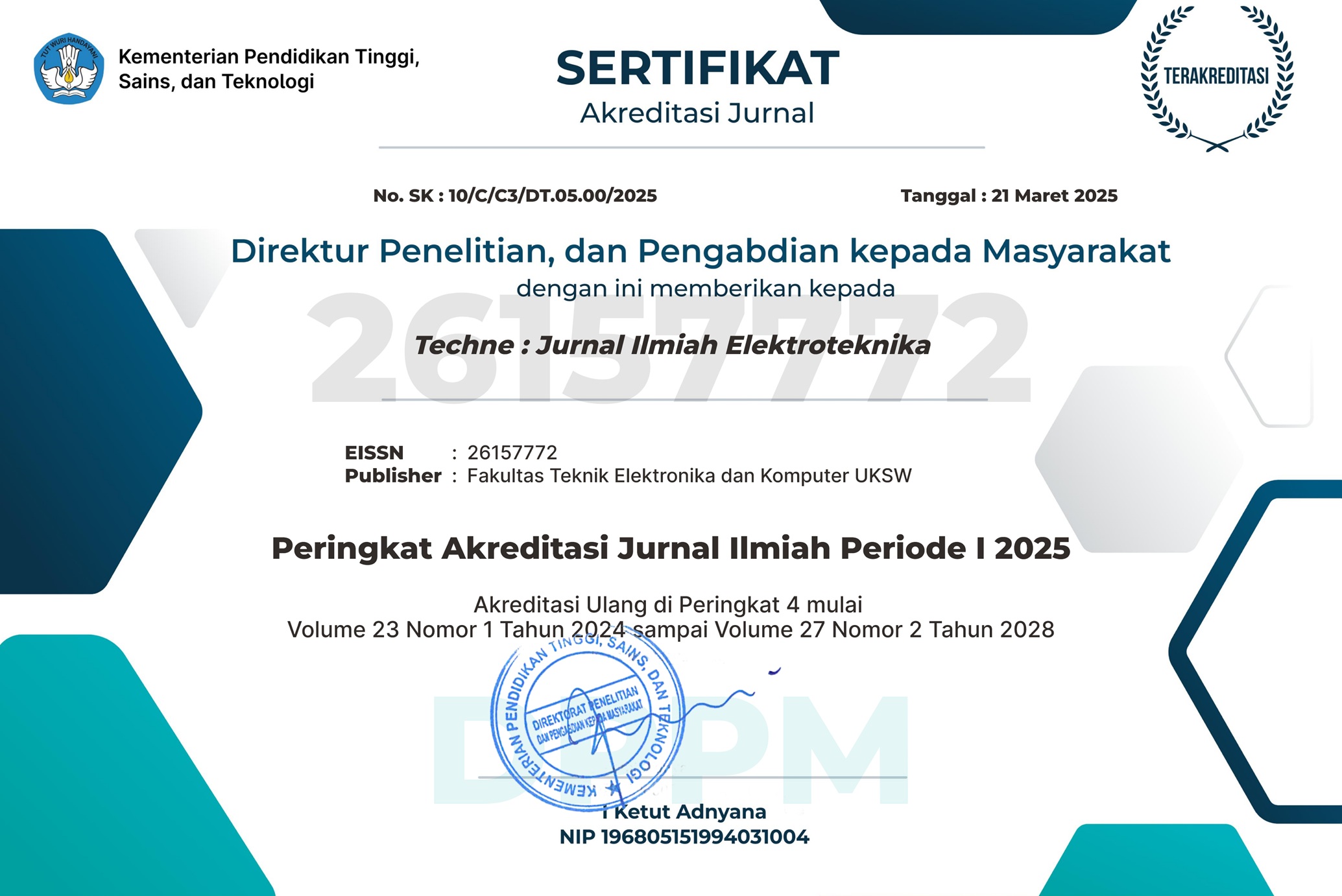Perancangan Sendok Makan Parkinson dengan Metode PID berbasis Arduino
DOI:
https://doi.org/10.31358/techne.v22i1.346Keywords:
Keywords: Parkinson, MPU6050 Sensor, PID ControllerAbstract
Parkinson's disease is a progressive disorder of the nervous system that affects the part of the brain that coordinates body movement. Tremors that often occur in the patient's hands can cause difficulty while eating. One method that can be used as assistive devices for Parkinson's sufferers is to make a spoon that can remain relatively stable. In this study, Parkinson's spoon is made equipped with an MPU6050 sensor which is used to read the rotational movement of the spoon. The read value will be forwarded to the Arduino Nano microcontroller and then calculated using the complementary filter method and the PID (Proportional Integral Derivative). Tuning on the values of Kp, Ki, and Kd in this research was done by trial and error method. In this research, the most optimal PID constant values were obtained, namely Kp = 0.7, Ki = 0.5, and Kd = 20 both on the pitch axis and roll axis. The results of the PID calculation will drive the SG90 servo motor to stabilize the spoon. Testing the percentage error of the MPU6050 sensor was carried out with 6 trials of different angles on the pitch and roll axes. The average error percentage on the pitch axis was 3.23%. and 2.583% on the roll axis. Based on testing the stability of the system against movement, spoon of Parkinson's can stabilize fairly quickly if it is moved slowly despite the initial overshoot, which the highest peak was -21,49 degrees on the pitch axis and -14,89 degrees on the roll axis. However, if the hands vibrate violently, in general the spoon still oscillates between -10 degrees and 10 degrees both on the pitch and roll axis.
Keywords: Parkinson, MPU6050 Sensor, PID Controller
Downloads
References
A.R. Onibala, C.D. Mambo, A.S.R. Masengi, “Peranan vitamin dalam penanganan penyakit Parkinson”, Jurnal Biomedik, Fakultas Kedokteran Universitas Sam Ratulangi, Manado, vol 13 no 3, 2021 pp. 322-333.
W. Aditya, “Klasifikasi Penyakit Parkinson Menggunakan Artificial Neural Network (Ann) Berdasarkan Ekstraksi Fitur Multifractal Detrended Fluctuation Analysis (Mfdfa) Pada Sinyal Gait,” Tugas akhir. Institut Teknologi Sepuluh Nopember, 2017. Accessed: Jul. 03, 2021. [Online]. Available: https://repository.its.ac.id/42195/
L. Aulia, “Hubungan Stadium Penyakit Parkinson dengan Kualitas Hidup Penderita di Rumah Sakit Islam Ibnu Sina Padang,” Diploma thesis, Fakultas Kedokteran, Universitas Andalas, 2020. Accessed: Jul 03, 2021. [Online].
Available: http://scholar.unand.ac.id/56985/
Suharti, “Patologi penurunan kognitif pada penderita Parkinson”, UMI Medical Journal, Fakultas Kedokteran Universitas Muslim Indonesia, vol 5 issue 1, Juni 2020, pp. 1-11
M. N. Halim, A. Zarkasi, and A. D. Nastiti, “Implementasi Logika Fuzzy Pada Sendok Makan Penderita Parkinson,” Generic, Jurnal Ilmu Komputer dan Teknologi Informasi, Universitas Sriwijaya, vol 12 no 1, 2020, pp. 4-13
A. Zarkasi, D. D. Mahendra, M. A. Fadilla, dan M. N. Halim, “Rancang bangun Sendok Penderita Parkinson Menggunakan Mikrokontroler ESP-32” di dalam Proceeding Annual Research Seminar, Fakultas Ilmu Komputer, Universitas Sriwijaya, vol 5 no 1, 2019, pp. 242-246.
J. Abrahamson, J. Danmo, “The stabilizing spoon, self-stabilizing utensil to help people with impaired motor skills”. Bachelor thesis, KTH Royal Institute of Technology, Stockholm, Sweden, 2017.
M. Rikhas dan H. Asyari, “Implementasi sesnsor MPU-6050 pada Perancangan Alat Bantu Makan Penderita Parkinson”, Simposium Nasional RAPI II, - 2021, FT Universitas Muhammadiyah Surakarta, pp135-142.
Marwanto, “Sifat Mekanik Komposit Berbasis Poli Asam Laktat (PLA) dan Serat Selulosa Tandan Kosong Kelapa Sawit”, Jurnal Hutan Lestari, vol 5 no 2, 2017, pp 412-417.
“What is Matlab? | How It Works | Skill & Career Growth | Advantages,” EDUCBA, Apr. 29, 2019. https://www.educba.com/what-is-matlab/ (accessed Jul. 03, 2021).
T. Islam, Md. S. Islam, Md. Shajid-Ul-Mahmud, and M. Hossam-E-Haider, “Comparison of complementary and Kalman filter based data fusion for attitude heading reference system,” AIP Conference Proceedings, vol 1919 no 1, Dhaka, Bangladesh, December 2017, pp. 0200021-10.
S. Colton, "The Balance Filter: a Simple Solution for Integrating Accelerometer and Gyroscope Measurements for a Balancing Platform", Massachusetts Institute of Technology, Cambridge, MA, Rev.1: Submitted as a Chief Delphi white paper, June 2007.
E. Fitrawan, S. Sulaiman, R.H. Subrata, Perancangan Sistem Kendali PID untuk sistem Two Wheels Self Balancing Robot, dalam Proceeding Seminar Nasional Pakar ke 3, Universitas Trisakti, 2020, pp 1.23.1- 1.23.5
“PID Controller: Working, Types, Advantages & Its Applications,” ElProCus - Electronic Projects for Engineering Students, Dec. 28, 2013.
https://www.elprocus.com/the-working-of-a-pid-controller/ (accessed Jul. 03, 2021).
A. Ningsih, C. Puspita, “Kendali PID Training Kit ELABO TS 3400 Menggunakan sensor Posisi”, Technee, Jurnal Ilmiah Elektroteknika, Universitas Satyawacana, vol 15 no 2, 2016, pp 9-16.
Downloads
Published
How to Cite
Issue
Section
License
Copyright (c) 2023 Newton Onasie, Susan Sulaiman

This work is licensed under a Creative Commons Attribution-NonCommercial-ShareAlike 4.0 International License.








